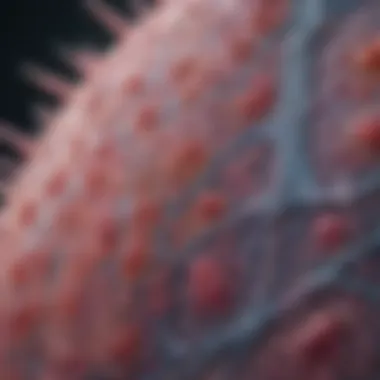Breast Fibroblast Cell Line in Biomedical Research


Intro
Breast fibroblast cell lines are a fundamental component of research in cancer biology and regenerative medicine. These specialized cells, which are part of the connective tissue, play a vital role in the tumor microenvironment. This article delves into the significance of breast fibroblast cell lines within biomedical research, detailing their characteristics, application methodologies, and ethical considerations.
Research Overview
Summary of Key Findings
Breast fibroblast cell lines have shown significant relevance in understanding tumor biology. They contribute to the study of heterogeneous cellular interactions within tumors. Fibroblasts are not passive bystanders; rather, they actively influence tumor progression, metastasis, and resistance to therapy. Various studies have revealed how these cells affect cancer cell behavior, including proliferation and migration. Through the production of growth factors and extracellular matrix components, fibroblasts shape the tumor microenvironment, providing insights that could lead to more effective treatment strategies.
Importance of the Research in Its Respective Field
Research involving breast fibroblast cell lines is pivotal. These cell lines not only enhance our understanding of breast cancer pathology but also offer platforms for testing therapeutic interventions. By examining how fibroblasts interact with malignant cells, researchers can identify potential targets for therapy. Moreover, understanding the roles of these fibroblasts can lead to advances in regenerative medicine, where manipulating fibroblasts may aid in tissue repair and regeneration.
Methodology
Description of the Experimental or Analytical Methods Used
Establishing and maintaining breast fibroblast cell lines generally involves isolating primary fibroblasts from breast tissue. The cells are typically cultured under specific conditions that replicate a conducive environment for their growth. Standard practices include using specific media supplements and growth factors to encourage proliferation. Researchers then conduct experiments to analyze cellular behavior, gene expression, and response to various treatments.
Sampling Criteria and Data Collection Techniques
Careful sampling criteria are crucial to ensure the reliability of the results. Primary fibroblasts are usually sourced from surgical specimens, ensuring that the cultured cells represent the in vivo environment as accurately as possible. Data collection often includes techniques such as flow cytometry, Western blotting, and qPCR to evaluate fibroblast characteristics and responses to stimuli. These methodologies provide a robust framework for gathering insights about these essential cells.
"Fibroblasts serve as critical mediators in the tumor microenvironment, influencing cancer cell behavior and therapeutic responses."
Overall, it is clear that breast fibroblast cell lines embody a rich resource for researchers. Understanding their function and impact on cancer and regenerative medicine opens avenues for innovative therapeutic developments. Through sophisticated methodologies and ethical considerations, this research is shaping the future of biomedical science.
Foreword to Breast Fibroblast Cell Lines
The study of breast fibroblast cell lines is vital in biomedical research, especially in understanding tumor biology and the surrounding microenvironment. Breast fibroblasts, which are a type of connective tissue cell, play significant roles in the architecture and function of breast tissue. Their interaction with other cells is crucial in the progression of various diseases, including cancer. Understanding these cells helps researchers develop better treatment strategies.
Definition of Fibroblasts
Fibroblasts are specialized cells that produce extracellular matrix components and collagen, providing structural support to tissues. They are essential for wound healing and tissue repair, maintaining the integrity of tissues throughout the body. In the breast, fibroblasts help maintain normal function and architecture, responding dynamically to hormonal changes. This definition lays the groundwork for comprehending their importance in both healthy and diseased states.
Historical Context
The exploration of fibroblasts has evolved significantly over decades. Initially, focus was mainly on fibroblast behavior in general wound healing. However, as research progressed, scientists identified their roles in cancer biology and the tumor microenvironment. In the late 20th century, advances in culture techniques allowed for the establishment of specific fibroblast lines, especially from breast tissue. This advancement provided a new avenue for studying tumor interactions and contributed to increased understanding of cancer development and metastasis. The historical context highlights the important transition from basic observations of fibroblasts to their critical role in complex biological systems.
Biological Characteristics of Fibroblasts
Breast fibroblast cell lines hold significance in biomedical research due to their unique biological characteristics. Understanding these characteristics is crucial for several reasons, particularly in the context of cancer research and regenerative medicine. Fibroblasts, as a type of connective tissue cell, play an essential role in maintaining structural integrity and function within tissues. By examining their biological characteristics, researchers can gain insights into how fibroblasts contribute to both normal physiology and pathological conditions.
Morphological Features
Fibroblasts exhibit a variety of morphological features that can vary based on origin and environmental factors. These cells generally have a spindle-like shape and can be identified by their elongated nuclei. The cytoplasm of fibroblasts may appear as either sparse or abundant based on their activation state. Under the microscope, these cells can show different arrangements—some appear scattered while others may form organized networks.
The visualization of fibroblast morphology is critical. Changes in shape and structure can indicate a shift in cellular function. For instance, when fibroblasts become activated during wound healing, their morphology changes to promote collagen production and tissue repair. Research utilizing cell imaging techniques, such as confocal microscopy, enhances our understanding of these dynamics. The following are key points about their morphology:
- Shape variability: Fibroblasts may appear more flattened or elongated depending on their state.
- Nuclear characteristics: Analyzing the size and shape of the nucleus can provide insight into cellular activity.
- Surface markers: Specific markers can aid in identifying different fibroblast subtypes and their functionality.
Functional Roles in Tissue Homeostasis
Fibroblasts play multifaceted roles in maintaining tissue homeostasis. They are not just passive structural elements; they are active participants in various physiological processes. Some of the essential functions include:


- Collagen synthesis: Fibroblasts are primarily responsible for producing collagen, which is vital for maintaining tissue strength and integrity.
- Secretion of growth factors: They produce signaling molecules that orchestrate the repair and maintenance of tissues.
- Matrix remodeling: During both normal tissue maintenance and repair processes, fibroblasts influence the extracellular matrix, ensuring a balance of degradation and synthesis.
By ensuring tissue integrity and responding to injury, fibroblasts significantly contribute to regenerative processes. For example, in the context of cancer, these cells interact with tumor cells, influencing tumor progression and response to therapies. Understanding these functional roles can help in developing better strategies in disease management, particularly in cancer therapies.
In summary, the biological characteristics of breast fibroblast cell lines not only reveal their distinct morphology but also their indispensable roles in promoting tissue health. As research progresses, these insights will drive future innovations in both therapeutic and diagnostic strategies in medicine.
"Fibroblasts are at the heart of connective tissue dynamics, making their study essential for understanding disease mechanisms."
For more information on fibroblasts and their functions, refer to Wikipedia and Britannica.
The Role of Breast Fibroblast Cell Lines in Cancer Research
Breast fibroblast cell lines are critical in cancer research, specifically in understanding tumor biology and developing novel therapies. These cell lines provide a unique model to study the interactions between fibroblasts and breast cancer cells, giving insights into cancer progression and metastasis. Their unique properties enable researchers to dissect the cellular mechanics of tumors, assess treatment efficacy, and explore potential therapeutic targets.
Interactions with Cancer Cells
Fibroblasts reside within the tumor microenvironment and play a pivotal role in bi-directional interactions with cancer cells. They secrete various signals and growth factors that can promote tumor growth, invasion, and angiogenesis. In return, cancer cells can influence the behavior of fibroblasts, pushing them toward an activated state, which in turn can further enhance tumor progression. For instance, studies show that fibroblasts release cytokines such as interleukin-6 and transforming growth factor-beta, which are known to facilitate tumor aggressiveness.
In research, breast fibroblast cell lines allow scientists to explore these interactions in detail. By co-culturing fibroblasts with different breast cancer cell lines, it becomes possible to analyze how the two cell types communicate. This co-culture faciliates the observation of changes in gene expression and cellular behavior, and helps to identify biomarkers associated with tumor development.
Impact on Tumor Microenvironment
The tumor microenvironment is complex, consisting of various cell types, extracellular matrix components, and signaling molecules. Breast fibroblast cell lines contribute significantly to this microenvironment by modulating its characteristics. Fibroblasts can modify the extracellular matrix, also known as ECM, which surrounds tumor cells, affecting their behavior and responsiveness to therapy.
Fibroblasts also interact with immune cells within the tumor environment. They can inhibit immune cell activity or promote a more immunosuppressive environment, enabling cancer cells to evade detection and destruction by the immune system. Consequently, understanding these interactions is essential for developing effective cancer immunotherapies. Research that utilizes breast fibroblast cell lines gives critical insight into how targeting fibroblasts could enhance tumor sensitivity to immunotherapy and improve overall patient outcomes.
"Understanding the interactions between fibroblasts and cancer cells provides essential insights into tumor biology, paving the way for innovative therapeutic strategies."
In summary, the role of breast fibroblast cell lines in cancer research is substantial. They not only help elucidate the molecular mechanisms driving cancer progression but also assist in formulating new treatment paradigms by targeting the tumor microenvironment.
Establishment of Breast Fibroblast Cell Lines
The establishment of breast fibroblast cell lines is a crucial aspect in biomedical research. Fibroblasts serve as key players in tissue scaffolding and support, playing indispensable roles in various biological processes. Their application in cancer research and regenerative medicine makes the establishment of such cell lines necessary. Effective cell line development hinges on specific sources and meticulous culturing techniques, ensuring the cells maintain their phenotypic and functional integrity.
Sources of Fibroblasts
Sources of fibroblasts can vary widely. These cells can be isolated from normal breast tissue, tumors, or even from established cell lines. The choice of source significantly influences the characteristics and behavior of the cell lines created.
- Normal Breast Tissue: Fibroblasts obtained from healthy breast tissue provide a benchmark for studying normal biological functions. They can reveal baseline behaviors not masked by oncogenic mutations.
- Tumor Tissue: Fibroblasts derived from tumors often exhibit altered properties that aid in understanding the tumor microenvironment. This can be essential for modeling interactions in cancer research.
- Established Cell Lines: Using existing fibroblast cell lines, such as MCF-10A or Hs578Bst, allows for reproducibility across experiments. However, they may lack the variability found in primary cells, limiting their application.
Selecting the right source requires a balance between availability and the specific scientific questions at hand.
Culturing Techniques
Culturing techniques are pivotal in maintaining the viability and functionality of fibroblast cell lines. The following aspects are essential:
Growth Medium Composition
The growth medium for fibroblasts must be carefully formulated. It typically includes essential nutrients, hormones, and growth factors to support cell growth.
- Key Characteristics: Media such as DMEM or RPMI-1640 are common. They provide a controlled environment for fibroblast proliferation and health.
- Unique Features: These media types can be supplemented with fetal bovine serum, which adds extra growth factors.
Choosing the right composition enhances growth rates and cellular characteristics, which is crucial for reproducibility in scientific studies.
Environmental Conditions
Environmental conditions also significantly affect fibroblast culture. This includes parameters such as temperature, gas composition, and humidity.


- Key Characteristics: Typically, fibroblasts are cultured at 37 degrees Celsius in a humidified atmosphere with 5% CO2. Such conditions mimic in vivo environments closely.
- Unique Features: Adjusting these parameters can impact cell behavior markedly. For example, oxygen levels can influence metabolism and proliferative capacity.
Maintaining appropriate environmental conditions not only ensures viability but also optimizes the functional characteristics of fibroblasts for further research applications.
“The deliberate choice of sources and techniques can vastly affect the subsequent applications of breast fibroblast cell lines in research.”
Applications of Breast Fibroblast Cell Lines
The exploration of breast fibroblast cell lines opens a gateway to significant scientific advancements. These cell lines are not merely laboratory tools; they serve pivotal roles in understanding breast cancer and other related diseases. Their applications extend from drug testing to regenerative medicine. This section delves into the multifaceted applications of breast fibroblast cell lines, focusing on three critical areas: drug testing and toxicology, modeling disease progression, and perspectives in regenerative medicine.
Drug Testing and Toxicology
Breast fibroblast cell lines provide an essential framework for drug testing and toxicology studies. Using these cell lines allows researchers to assess how breast tissue responds to different drug compounds. Here, scientists can evaluate the efficacy and safety of new drugs before they reach clinical trials. This process can significantly reduce the time and costs associated with drug development.
By employing breast fibroblast cell lines, researchers can:
- Examine pharmacokinetics: Understand how drugs are absorbed, distributed, metabolized, and excreted.
- Assess cytotoxicity: Determine whether a drug harms fibroblasts, which is crucial in evaluating potential side effects.
- Evaluate drug interactions: Study how various drugs may affect cellular responses and interactions.
Overall, the insights gathered from fibroblast cell lines can guide the selection of compounds that show promise for further investigation.
Modeling Disease Progression
In modeling disease progression, breast fibroblast cell lines serve as invaluable tools. Breast cancer is characterized by a complex interplay between tumor cells and the surrounding fibroblasts. By using these cell lines, researchers can recreate elements of the tumor microenvironment, thereby gaining insights into the processes that drive cancer development and progression.
Key aspects of using fibroblast cell lines in disease modeling include:
- Studying tumor-stroma interactions: Understanding how cancer cells manipulate fibroblasts to support tumor growth.
- Investigating metastasis: Exploring how fibroblasts can aid in the spread of cancer cells to other parts of the body.
- Assessing treatment responses: Evaluating how various therapies affect both fibroblast and tumor cell behavior in a controlled environment.
This modeling enables researchers to test hypotheses regarding cancer biology, paving the way for new therapeutic strategies.
Regenerative Medicine Perspectives
The potential for breast fibroblast cell lines in regenerative medicine is particularly promising. Fibroblasts are crucial for tissue repair and regeneration due to their ability to produce extracellular matrix components and growth factors.
Applications include:
- Tissue engineering: Using fibroblasts in scaffolds to support tissue formation.
- Wound healing studies: Investigating the role of fibroblasts in healing processes, which can lead to advances in therapies for chronic wounds.
- Stem cell research: Fibroblasts can be reprogrammed into induced pluripotent stem cells (iPSCs), which have broad applications in regenerative therapies.
This research contributes to the development of new treatments for a range of conditions, from injuries to degenerative diseases.
"Breast fibroblast cell lines are transforming the landscape of biomedical research by bridging the gap between laboratory studies and clinical applications."
Ethical Considerations in the Use of Fibroblast Cell Lines
The application of breast fibroblast cell lines in biomedical research raises several important ethical considerations. These considerations are crucial because they affect the manner in which research is conducted and how the results are interpreted. Understanding these ethical dimensions helps ensure that researchers act responsibly and uphold the integrity of science.
Tissue Donation and Consent
A primary ethical issue related to breast fibroblast cell lines is the need for proper tissue donation and the acquisition of informed consent from donors. Consent is more than a mere formality; it represents the voluntary agreement of individuals to contribute their biological materials for research purposes. Researchers must ensure that donors are fully aware of how their tissues will be used, potential risks, and the scope of the research. The transparent communication of this information is essential in fostering trust between researchers and the community.
Often, institutions establish ethical oversight boards to review proposed studies and ensure adherence to consent protocols. By following these frameworks, researchers demonstrate respect for the autonomy of participants, ensuring they are active participants rather than anonymous contributors.
Potential for Misuse
Another significant ethical consideration pertains to the potential for misuse of fibroblast cell lines. The accessibility of these cell lines can lead to misuse in various forms, including experiments that may not align with the original intent of the research or exploitative practices without regard to ethical principles. Misuse can occur in several contexts, from inappropriate application of research findings to unethical commercial interests.
It is vital for the scientific community to establish strong guidelines that restrict the use of fibroblast cell lines to ethical research purposes.
This includes ensuring that any derived knowledge is utilized to promote public health and welfare. Additionally, ongoing dialogue among researchers, ethicists, and policymakers can help mitigate potential abuses associated with fibroblast cell lines. Clear regulations and accountability mechanisms are necessary to navigate this complex ethical landscape, safeguarding the interests of both donors and the broader community.


Understanding and addressing these ethical considerations is essential for promoting responsible research. Informed consent and awareness of potential misuse are cornerstones of ethical research practices that uphold respect for individuals while advancing scientific knowledge.
Future Directions in Research
Understanding the future directions in the field of breast fibroblast cell lines is vital for advancing biomedical research. The evolution of techniques and the innovative strategies being developed can significantly enhance the utility of these cell lines. Researchers must remain informed about the trends and emerging methodologies that promise to expand our comprehension of breast biology, cancer pathology, and therapeutic settings.
Innovative Techniques in Cell Line Development
The development of breast fibroblast cell lines has seen notable advancements in recent years. These innovative techniques not only improve cell line establishment but also enhance the reliability of research outcomes. Some prominent approaches include:
- 3D Culture Systems: These systems mimic in vivo conditions more closely than traditional 2D cultures. Using 3D matrices, researchers can observe more relevant biological behaviors, which may lead to better drug responses.
- CRISPR/Cas9 Gene Editing: This technique allows for precise modifications in the cellular genome. By applying CRISPR, scientists can create cell lines with specific genetic mutations that model particular cancer types. This has great implications for personalized medicine and targeted therapies.
- Induced Pluripotent Stem Cells (iPSCs): The use of iPSCs to derive fibroblasts enables researchers to generate patient-specific lines. These can offer more personalized insights, especially in drug testing and response evaluations.
By integrating such approaches, researchers can create more representative models for studying breast cancer and evaluative responses to treatments.
Integration with Other Cell Types
Integrating breast fibroblast cell lines with other cell types presents an exciting frontier in biomedical research. This synergy can yield a more comprehensive understanding of tumor biology and its microenvironment. Potential integrations include:
- Co-culture Systems: Studying fibroblasts alongside breast cancer cells allows for the examination of their interactions. This can shed light on how fibroblasts influence tumor growth, invasion, and response to therapies.
- Immune Cells: Including immune cells in fibroblast cultures can help researchers explore the immune response to tumors. Understanding these dynamics is crucial for improving immunotherapy approaches.
- Vascular Cells: Endothelial cells can be added to assess how fibroblasts contribute to angiogenesis in tumors. This knowledge is important for targeting blood supply in cancer treatments.
The incorporation of diverse cell types leads to an enhanced representation of tissue complexity in research settings. This can potentially unveil new therapeutic targets and improve outcomes in cancer treatment.
As the field continues to progress, staying attuned to these future directions will enable researchers to leverage breast fibroblast cell lines effectively, ultimately advancing scientific discovery.
Closure
In this article, we have explored the multifaceted role of breast fibroblast cell lines within biomedical research. Understanding their significance is essential, given their profound implications for cancer research and regenerative medicine. Breast fibroblasts contribute not just as structural components but actively influence tumor dynamics and responses to therapy. Their interactions with cancer cells underscore the complexity of the tumor microenvironment, highlighting their necessity as model systems in research.
Summary of Key Insights
- Biological Role: Breast fibroblasts play a crucial role in maintaining tissue architecture and functionality. They secrete extracellular matrix proteins, which provide structural support, and influence the behavior of adjacent cells. This biological function is integral to both normal physiology and pathological conditions such as cancer.
- Research Applications: The utility of breast fibroblast cell lines extends into several fields, including drug testing, toxicology, and personalized medicine. They serve as in vitro models to study the interaction between stromal and tumor cells, enabling researchers to unravel complex biological processes.
- Ethical Considerations: The derivation and use of fibroblast cell lines raise important ethical questions regarding consent and potential misuse. A careful approach to these issues is necessary to ensure the responsible use of biological materials in research.
Implications for Future Research
Future research involving breast fibroblast cell lines is poised for expansion. As new technologies emerge, such as single-cell RNA sequencing or advanced imaging techniques, there will be opportunities to gain deeper insights into fibroblast behavior in various contexts.
- Innovative Techniques: The adoption of cutting-edge methods in cell line development will enhance our understanding of fibroblast roles. For instance, combining fibroblast lines with stem cell technologies may elucidate mechanisms of tumor progression and therapy response.
- Integration with Other Cell Types: Collaborations between fibroblast lines and other cellular models, such as immune cells or epithelial cell lines, could provide a more comprehensive understanding of tumor biology. This integrated approach may lead to novel therapeutic strategies targeting stromal interactions in breast cancer.
Overall, the role of breast fibroblast cell lines in biomedical research is crucial, providing a platform for innovative discoveries and potential advancements in treatment protocols. The insights gained through this research not only enrich our understanding of breast cancer but also offer avenues for enhancing patient care.
Cited Works
The cited works section is essential as it lists all the primary research articles, reviews, and other scholarly sources referenced throughout the article. This section enables the audience to access the original studies that contributed to the understanding of breast fibroblast cell lines. It generally includes:
- Author names
- Publication year
- Article title
- Journal name
- Volume and page numbers or DOI link.
For example:
- Smith, J. (2020). The role of fibroblasts in breast cancer progression. Journal of Oncology Research, 45(2), 123-134.
- Johnson, A., & Lee, T. (2019). Impact of fibroblast interactions on tumor microenvironment. Cancer Biology Reviews, 12(4), 67-79.
Including comprehensive citations helps guide readers to quality resources for their own exploration and enhances the scholarly value of the article.
Further Reading
The further reading section offers an opportunity to expand the educational context of the article. This section often includes books, review articles, and other resources that provide broader insights or a historical perspective on fibroblasts and their significance in biomedical research. Suggested materials might feature:
- Comprehensive reviews of tumor microenvironment research
- Textbooks on cancer biology and fibroblasts
- Online databases like PubMed for accessing articles
This additional reading cultivates a deeper understanding of the subject matter. Not only does it enhance the knowledge base, but it also encourages further inquiry into ongoing research and advancements in the field. Here are some potential resources:
- Fibroblasts: Methods and Protocols by D. Anderson.
- Recent reviews on fibroblast functions in various cancer types.
- Online platforms like Wikipedia for quick definitions and foundational knowledge.
By providing these references and further reading suggestions, the article equips students, researchers, and professionals with the tools they need to deepen their understanding and engage with the topic effectively.







